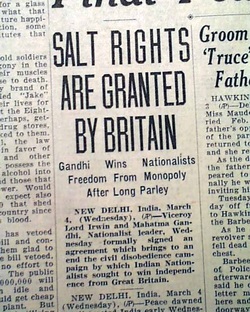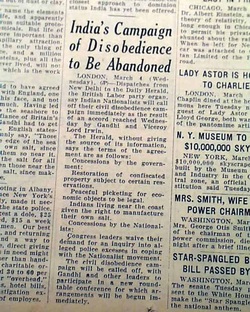The Salt March had many effects that truly changed the world for good. When Gandhi picked up that grain of salt in Dandi, he set off a chain reaction throughout India that would change its history. News of the daring act reached all around the world, and was an inspiration to minorities who needed a voice in happenings. Before the Salt March, many Indians had been losing hope that they would eventually become their own country. However, the Salt March gave them new hope in the fight for India's independence.
Jawarhal Nehru, future Prime Minister of India, stated:
Jawarhal Nehru, future Prime Minister of India, stated:
"Of course these movements exercised tremendous pressure on the British Government and shook the government machinery. But the real importance, to my mind, lay in the effect they had on our own people, and especially the village masses....Non-cooperation dragged them out of the mire and gave them self-respect and self-reliance....They acted courageously and did not submit so easily to unjust oppression; their outlook widened and they began to think a little in terms of India as a whole....It was a remarkable transformation and the Congress, under Gandhi's leadership, must have the credit for it."
The Gandhi-Irwin Pact
Another effect of the Salt March led to the Gandhi-Irwin Pact, which got rid of the salt taxes and greatly helped the poor. It also called for the nonviolent campaign, led by Gandhi, to stop. Although the terms were not exactly what Gandhi had wanted, they were needed. The leading Indian nationalists were also freed as a result of this pact.
The newspaper states that the terms of the agreement were:
"Concessions by the government:
Restoration of confiscated property subject to certain reservations.
Peaceful picketing for economic objects to be legal.
Indians living near the coast being given the right to manufacture their own salt.
Concessions by the Nationalists:
Congress leaders waive their demand for an inquiry into alleged police excesses in coping with the Nationalist movement.
The civil disobedience campaign will be called off, with Gandhi and other leaders to participate in a new round-table conference"
Long Term
Gandhi inspired many freedom fighters with his legendary actions and the Salt March. For example, Martin Luther King Jr. once said,
"Like most people, I had heard of Gandhi, but I had never studied him seriously. As I read I became deeply fascinated by his campaigns of nonviolent resistance. I was particularly moved by his Salt March to the Sea and his numerous fasts. The whole concept of Satyagraha (Satya is truth which equals love, and agraha is force; Satyagraha, therefore, means truth force or love force) was profoundly significant to me. As I delved deeper into the philosophy of Gandhi, my skepticism concerning the power of love gradually diminished, and I came to see for the first time its potency in the area of social reform."
The Gandhi–Irwin Pact was a political agreement signed by Mahatma Gandhi and the then Viceroy of India, Lord Irwin on 5 March 1931 before the second Round Table Conference in London.[1] Before this, the viceroy Lord Irwin announced in October 1929, a vague offer of 'dominion status' for India in an unspecified future and a Round Table Conference to discuss a future constitution.[2]
"The Two Mahatmas"—as Sarojini Naidu described Gandhi and Irwin—had eight meetings that totaled 24 hours. Gandhi was impressed by Irwin’s sincerity. The terms of the "Gandhi-Irwin Pact" fell manifestly short of those Gandhi prescribed as the minimum for a truce.[3]
Below were the proposed conditions.
- Discontinuation of the civil disobedience movement by the Indian National Congress
- Participation by the Indian National Congress in the Round Table Conference
- Withdrawal of all ordinances issued by the British Government imposing curbs on the activities of the Indian National Congress
- Withdrawal of all prosecutions relating to several types of offenses except those involving violence
- Release of prisoners arrested for participating in the civil disobedience movement
- Removal of the tax on salt, which allowed the Indians to produce, trade, and sell salt legally and for their own private use
It is fair to record that British officials in India, and in England, were outraged by the idea of a pact with a party whose avowed purpose was the destruction of the British Raj.Winston Churchill publicly expressed his disgust "...at the nauseating and humiliating spectacle of this one-time Inner Temple lawyer, now seditious fakir, striding half-naked up the steps of the Viceroy’s palace, there to negotiate and parley on equal terms with the representative of the King Emperor."
In reply, the British Government agreed to
- Withdraw all ordinances and end prosecutions
- Release all political prisoners, except those guilty of violence
- Permit peaceful picketing of liquor and foreign cloth shops
- Restore confiscated properties of the satyagrahis
- Permit free collection or manufacture of salt by persons near the sea-coast
- Lift the ban over the congress.
The Viceroy, Lord Irwin, was at this time directing the sternest repression Indian nationalism had known, but did not relish the role. The British civil service and the commercial community favoured even harsher measures. But Premier Ramsay MacDonald and Secretary of State for India William Benn were eager for peace, if they could secure it without weakening the position of the Labour Government. They wanted to make a success of the Round Table Conference and knew that this body, without the presence of Gandhi and the Congress, could not carry much weight. In January 1931, at the closing session of the Round Table Conference, Ramsay MacDonald went so far as to express the hope that the Congress would be represented at the next session. The Viceroy took the hint and promptly ordered the unconditional release of Gandhi and all members of the Congress Working Committee. To this gesture Gandhi responded by agreeing to meet the Viceroy.
Gandhi’s motives in concluding a pact with the Viceroy can be best understood in terms of his technique. The Satyagraha movements were commonly described as "struggles", "rebellions" and "wars without violence". Owing, however, to the common connotation of these words, they seemed to lay a disproportionate emphasis on the negative aspect of the movements, namely, opposition and conflict. The object of Satyagraha was, however, not to achieve the physical elimination or moral breakdown of an adversary—but, through suffering at his hands, to initiate a psychological processes that could make it possible for minds and hearts to meet. In such a struggle, a compromise with an opponent was neither heresy nor treason, but a natural and necessary step. If it turned out that the compromise was premature and the adversary was unrepentant, nothing prevented the Satyagrahi from returning to non-violent battle..

No comments:
Post a Comment